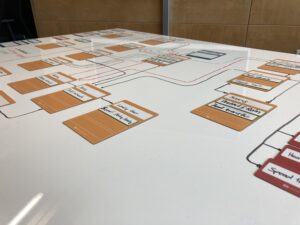In today’s increasingly complex product development landscape, the need for effective collaboration across multiple engineering disciplines has never been greater. System models have emerged as a crucial tool for bridging the gap between mechanical, electrical, and software engineering teams.
What is a System Model?
A system model is more than just another digital representation in your development toolkit. It’s a specialized model that serves as a common language across multiple engineering disciplines and technical domains. Unlike discipline-specific models that focus on a single area of expertise, system models integrate various perspectives to provide a holistic view of the product being developed.
The Model Cube: A Framework for Classification
To better understand and categorize different types of models in product development, researchers have developed the “Model Cube” – a three-dimensional framework with the following axes:
1. System Level
- System-wide view: Complete product perspective
- Subsystem level: Major component groups
- Component level: Individual parts and elements
2. Disciplines Involved
The more engineering disciplines involved (mechanical, electrical, software, etc.), the more likely it is to be considered a system model rather than a discipline-specific model.
3. Technical Domain
This covers what aspect of the system the model describes:
- Requirements modeling
- Structural modeling
- Behavioral modeling
- Other technical aspects
Key Insight: When a model involves multiple disciplines AND covers multiple technical domains, it qualifies as a system model.
Model cube paper: https://link.springer.com/article/10.1007/s42452-019-1069-0
Adopted in ISO/IEC/IEE 24641:2023 https://www.iso.org/standard/79111.html
The CAD Model Question
A common question in industry is: “Is a CAD model automatically a system model?” The answer depends on context and perspective. A CAD model of an entire vehicle might be considered discipline-specific when viewed from a system architecture standpoint. However, for the design team, that same CAD model could serve as a system model if it’s the central integration point for multiple engineering disciplines.
Why System Models Matter More Than Ever
Modern product development faces several trends that make system models increasingly critical:
- Disappearing single-discipline development: Pure mechanical or electrical products are becoming rare
- Growing software integration: Electronics and software now drive the features customers are willing to pay premium prices for
- Complex interdisciplinary communication: Different disciplines speak different technical languages and follow different development philosophies
System models provide the abstraction level needed for effective cross-disciplinary communication, allowing teams to build shared understanding before diving into discipline-specific details.
One Model to Rule Them All?
Despite the appeal of having a single, comprehensive system model for entire product development, this approach contradicts fundamental modeling principles. According to modeling theory, every model serves a specific purpose and should embody the “reduction feature” – meaning it intentionally simplifies reality for that purpose.
The reality: Multiple system models are necessary and beneficial for comprehensive product development, provided they are properly aligned and managed.
Looking Forward
As products become increasingly complex and interdisciplinary, system models will play an ever more critical role in successful product development. They serve as the essential bridge between different engineering worlds, enabling the integration that modern products demand.
The key is not to search for the perfect universal model, but to develop multiple, well-coordinated system models that serve their specific purposes while maintaining alignment across the entire development process.









